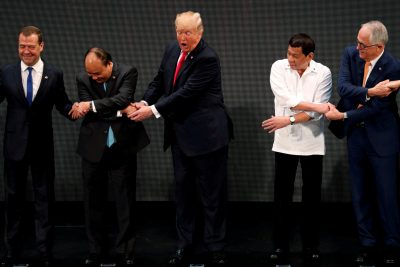Success ensures ASEAN’s long-term importance to the United States
March 27, 2018 at 09:26
Success ensures ASEAN’s long-term importance to the United States
At the APEC Summit in November 2017, US President Donald Trump declared, ‘We are not going to let the United States be taken advantage of anymore … I am always going to put America first’.

Considering Trump’s ‘America First’ philosophy and his disdain for past trade agreements — sentiments proclaimed at the Da Nang APEC summit and on numerous other occasions — it’s reasonable to conclude that ASEAN plays no role in Trump’s world view. But Trump is president for a defined term. His views on US relations with the rest of the world neither represent mainstream opinion nor define the importance of ASEAN to the United States.
ASEAN, in fact, is vitally important to the United States for several reasons.
Perhaps most importantly, ASEAN has successfully pursued good politics alongside good economics. At its inception in 1967, ASEAN was intended to put an end to guerrilla conflicts between Indonesia, Malaysia and the Philippines. Owing in large measure to ASEAN, those conflicts have long since been relegated to the history books.
Today ASEAN serves both as an economic partner with China and as a bulwark against incremental Chinese expansion. None of the ASEAN countries individually carries much heft in geopolitical contests but collectively they represent a considerable force. The United States badly needs regional powers that can counterbalance China’s growing geopolitical footprint. The three most important powers in this respect are India, Japan and ASEAN.
ASEAN has also fostered the explosive growth of supply chains, both among its members and with outside powers, notably China, the United States, Japan and Europe. No one in 1967 thought much about supply chains. Trade was dominated by natural resources on the one hand (such as oil, copper and other commodities) and finished products made by vertically integrated firms on the other (including clothing, furniture, steel and turbines).
The supply chain revolution has enabled the magic of comparative advantage to operate on a far grander scale since each component — of a good or a service — can now be produced or assembled in the best location. The revolution has greatly benefitted the United States with less expensive footwear, TVs, computers, smart phones and many other products.
ASEAN’s success has served as a paradigm for troubled regions elsewhere. The United States has grown wearyof its erstwhile role as ‘policeman of the world’, but fortunately the need for this service is greatly diminished when neighbouring countries get along. An immensely successful regional grouping, patterned after ASEAN, is the Pacific Alliance that joins Chile, Peru, Colombia and Mexico.
Groupings in Africa are less successful. The Arab Maghreb Union is perhaps the least successful, joining only on paper the North African states from Morocco to Libya. ASEAN can pride itself on providing a model for successful regional groups elsewhere and being an aspiration for the less successful groups.
ASEAN Summit meetings, at which leaders dialogue with external powers such as China, Europe, Japan, India, Australia and the United States, make it much easier for US political leaders to hold productive meetings with their regional counterparts. The time of senior ministers is their scarcest resource. The ability of US secretaries of commerce, state, treasury and other departments to meet with all the leaders of Southeast Asia in a single week is highly valued.
Future ASEAN integration could provide a strong lure for future US presidents to reconsider membership in the renewed Comprehensive and Progressive Agreement for Trans-Pacific Partnership (CPTPP). Three ASEAN members — Singapore, Malaysia and Vietnam — are already members of the CPTPP. Conceivably, over the next five years, the CTTPP will expand to include Indonesia, Thailand, the Philippines and perhaps one or two other ASEAN members.
Future US presidents will have to reconsider the political and economic losses resulting from self-inflicted exclusion from such a powerful bloc. The case for US membership will be strengthened if the Regional Comprehensive Economic Partnership is concluded between China, India, all of ASEAN, Japan, South Korea, Australia and New Zealand.
By enlarging trade between its members, ASEAN has significantly raised standards of living across Southeast Asia. The United States prospers when the rest of the world prospers. The global expansion of trade and investment over the past 70 years has made an enormous contribution to levels of wellbeing worldwide, especially in Asia.
Indeed, according to the pioneering analysis by Angus Maddison of economic growth over the very long term, the post-World War II period has been the best in human history. As part of this advance, ASEAN has dramatically improved the livelihoods of hundreds of millions of people.
ASEAN leaders and observers should look beyond the shadow of neglect emanating from the current administration in Washington. Over the longer term, there can be no doubt as to the importance of ASEAN not only for US geopolitical goals in Asia but also for US prosperity through economic interdependence.
























